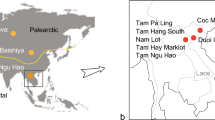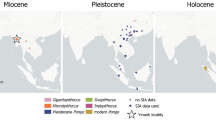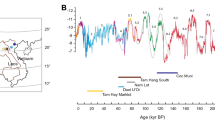Abstract
Ranging and residence patterns among early hominins have been indirectly inferred from morphology1,2, stone-tool sourcing3, referential models4,5 and phylogenetic models6,7,8. However, the highly uncertain nature of such reconstructions limits our understanding of early hominin ecology, biology, social structure and evolution. We investigated landscape use in Australopithecus africanus and Paranthropus robustus from the Sterkfontein and Swartkrans cave sites in South Africa using strontium isotope analysis, a method that can help to identify the geological substrate on which an animal lived during tooth mineralization. Here we show that a higher proportion of small hominins than large hominins had non-local strontium isotope compositions. Given the relatively high levels of sexual dimorphism in early hominins, the smaller teeth are likely to represent female individuals, thus indicating that females were more likely than males to disperse from their natal groups. This is similar to the dispersal pattern found in chimpanzees9, bonobos10 and many human groups11, but dissimilar from that of most gorillas and other primates12. The small proportion of demonstrably non-local large hominin individuals could indicate that male australopiths had relatively small home ranges, or that they preferred dolomitic landscapes.
This is a preview of subscription content, access via your institution
Access options
Subscribe to this journal
Receive 51 print issues and online access
$199.00 per year
only $3.90 per issue
Buy this article
- Purchase on Springer Link
- Instant access to full article PDF
Prices may be subject to local taxes which are calculated during checkout



Similar content being viewed by others
Change history
29 June 2011
Figure 2 has been corrected online in the HTML and the PDF versions; please see the corresponding Corrigendum.
References
Antón, S. C., Leonard, W. R. & Robertson, M. An ecomorphological model of the initial hominid dispersal from Africa. J. Hum. Evol. 43, 773–785 (2002)
Wheeler, P. E. The thermoregulatory advantages of large body size for hominids foraging in savanna environments. J. Hum. Evol. 23, 351–362 (1992)
Ambrose, S. H. Paleolithic technology and human evolution. Science 291, 1748–1753 (2001)
McGrew, W. C. in Woman the Gatherer (ed. Dahlberg, F. ) 35–73 (Yale Univ. Press, 1981)
Moore, J. in Great Ape Societies (eds McGrew, W. C., Marchant, L. F. & Nishida, T. ) 275–292 (Cambridge Univ. Press, 1996)
Ghiglieri, M. P. Sociobiology of the great apes and the hominid ancestor. J. Hum. Evol. 16, 319–357 (1987)
Wrangham, R. W. in The Evolution of Human Behavior: Primate Models (ed. Kinzey, W. G. ) 51–71 (State Univ. of New York Press, 1987)
Foley, R. & Gamble, C. The ecology of social transitions in human evolution. Phil. Trans. R. Soc. B 364, 3267–3279 (2009)
Goodall, J. The Chimpanzees of Gombe: Patterns of Behavior (Harvard Univ. Press, 1986)
Furuichi, T. Social interactions and the life history of female Pan paniscus in Wamba, Zaire. Int. J. Primatol. 10, 173–197 (1989)
Ember, C. R. Myths about hunter-gatherers. Ethnology 17, 439–448 (1978)
Robbins, M. M. et al. Social structure and life-history patterns in western gorillas (Gorilla gorilla gorilla). Am. J. Primatol. 64, 145–159 (2004)
Copeland, S. R. et al. Strontium isotope ratios in fossil teeth from South Africa: assessing laser ablation MC-ICP-MS analysis and the extent of diagenesis. J. Archaeol. Sci. 37, 1437–1446 (2010)
Copeland, S. R. et al. Strontium isotope ratios (87Sr/86Sr) of tooth enamel: a comparison of solution and laser ablation MC-ICP-MS methods. Rapid Commun. Mass Spectrom. 22, 3187–3194 (2008)
Hurst, R. W. & Davis, T. E. Strontium isotopes as tracers of airborne fly ash from coal-fired power plants. Environ. Geol. 3, 363–367 (1981)
Gosz, J. R., Brookins, D. G. & Moore, D. I. Using strontium isotope ratios to estimate inputs to ecosystems. Bioscience 33, 23–30 (1983)
Graustein, W. C. in Stable Isotopes in Ecological Research (eds Rundel, P. W. Ehleringer, J. R. & Nagy, K. A. ) 491–512 (Springer, 1989)
Faure, G. & Powell, T. Strontium Isotope Geology (Springer, 1972)
Sillen, A., Hall, G., Richardson, S. & Armstrong, R. 87Sr/86Sr ratios in modern and fossil food-webs of the Sterkfontein Valley: implications for early hominid habitat preferences. Geochim. Cosmochim. Acta 62, 2463–2473 (1998)
Beynon, A. D. & Dean, M. C. Distinct dental development patterns in early fossil hominids. Nature 335, 509–514 (1988)
Price, T. D., Burton, J. H. & Bentley, R. A. The characterization of biologically available strontium isotope ratios for the study of prehistoric migration. Archaeometry 44, 117–135 (2002)
McHenry, H. M. & Coffing, K. Australopithecus to Homo: transformations in body and mind. Annu. Rev. Anthropol. 29, 125–146 (2000)
Mahler, P. E. Metric Variation in the Pongid Dentition. PhD thesis, Univ. Michigan. (1973)
Plavcan, J. M. & van Schaik, C. P. Interpreting hominid behavior on the basis of sexual dimorphism. J. Hum. Evol. 32, 345–374 (1997)
Lockwood, C. A., Menter, C. G., Moggi-Cecchi, J. & Keyser, A. W. Extended male growth in a fossil hominin species. Science 318, 1443–1446 (2007)
Tooby, J. & DeVore, I. in The Evolution of Human Behavior: Primate Models (ed. Kinzey, W. G. ) 183–237 (State Univ. of New York Press, 1987)
Rodman, P. S. & McHenry, H. M. Bioenergetics and the origin of hominid bipedalism. Am. J. Phys. Anthropol. 52, 103–106 (1980)
McHenry, H. M. & Berger, L. Body proportions in Australopithecus afarensis and A. africanus and the origin of the genus Homo . J. Hum. Evol. 35, 1–22 (1998)
Charlier, B. L. A. et al. Methods for the microsampling and high-precision analysis of strontium and rubidium isotopes at single crystal scale for petrological and geochronological applications. Chem. Geol. 232, 114–133 (2006)
Acknowledgements
Funding for this project was provided by the National Science Foundation, USA (grant 0609963), the Max Planck Society, a University of Colorado LEAP Associate Professor Growth Grant and the University of Colorado Dean’s Fund for Excellence. We are grateful to the Ditsong National Museum of Natural History (formerly the Transvaal Museum), including F. Thackeray, S. Potze and T. Kearny, for allowing us access to the Sterkfontein and Swartkrans fossil material and for granting permission for laser ablation MC-ICP-MS analysis. We thank S. Potze and T. Perregil for flying to Cape Town to allow laser ablation MC-ICP-MS sampling of the hominins. We also thank L. Berger, J. Brophy, J. Codron and J. Hancox for help in the field, J. Montgomery for useful discussions and J. Sealy and J. Lanham for help with plant preparation in the Archaeology Department, University of Cape Town. We thank A. Anderson, C. Campbell, B. Covert, D. Grimstead, F. Grine, J. Leichliter, O. Paine, J. Quade, P. Sandberg and P. Ungar for commenting on the manuscript. The research of A. Sillen and G. Hall inspired this study.
Author information
Authors and Affiliations
Contributions
M.S. and J.A.L.-T. conceived the project. S.R.C., M.S., D.J.d.R., J.A.L.-T. and D.C. conducted fieldwork. D.J.d.R. chose hominin tooth specimens and made occlusal measurements. S.R.C., D.J.d.R., J.A.L.-T. and P.J.l.R. performed laser ablation MC-ICP-MS analyses. S.R.C. and V.G. performed solution MC-ICP-MS analyses. M.P.R. directed analyses at MPI-EVA. S.R.C., M.S., D.J.d.R. and D.C. wrote the manuscript. All authors discussed the results and commented on the manuscript. M.S. was principal investigator for the project.
Corresponding author
Ethics declarations
Competing interests
The authors declare no competing financial interests.
Supplementary information
Supplementary Information
This file contains a Supplementary Discussion, Supplementary Figures 1-2 with legends, Supplementary Tables 1-7 and additional references. (PDF 578 kb)
Rights and permissions
About this article
Cite this article
Copeland, S., Sponheimer, M., de Ruiter, D. et al. Strontium isotope evidence for landscape use by early hominins. Nature 474, 76–78 (2011). https://doi.org/10.1038/nature10149
Received:
Accepted:
Published:
Issue Date:
DOI: https://doi.org/10.1038/nature10149
This article is cited by
-
Why the geosciences are becoming increasingly vital to the interpretation of the human evolutionary record
Nature Ecology & Evolution (2023)
-
Our Grandmothers’ Legacy: Challenges Faced by Female Ancestors Leave Traces in Modern Women’s Same-Sex Relationships
Archives of Sexual Behavior (2022)
-
Growth and development of the third permanent molar in Paranthropus robustus from Swartkrans, South Africa
Scientific Reports (2020)
-
Elemental signatures of Australopithecus africanus teeth reveal seasonal dietary stress
Nature (2019)
-
Strontium and stable isotope evidence of human mobility strategies across the Last Glacial Maximum in southern Italy
Nature Ecology & Evolution (2019)
Comments
By submitting a comment you agree to abide by our Terms and Community Guidelines. If you find something abusive or that does not comply with our terms or guidelines please flag it as inappropriate.



